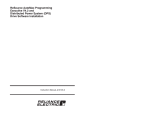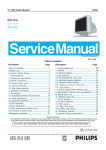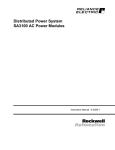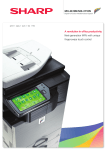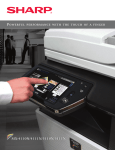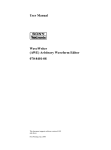Download J2-3107-1, ReSource AutoMax Programming
Transcript
! ! " The information in this user's manual is subject to change without notice. Nortont is a trademark of Peter Norton Computing. VAXt and VAX/VMSt are trademarks of Digital Equipment Corporation. IBMt and OS/2 are trademarks of International Business Machines Corporation. Microsoft, Windows, and MSĆDOS are trademarks of Microsoft Corporation. AutoMaxt and ReSource are registered trademarks of Reliance Electric Company or its subsidiaries. E1998 Rockwell International Corporation. Table of Contents 1.0 Introduction . . . . . . . . . . . . . . . . . . . . . . . . . . . . . . . . . . . . . . . . . . . . . . . . 1Ć1 ! " 2.0 Personal Computer Requirements . . . . . . . . . . . . . . . . . . . . . . . . . . . . 2Ć1 3.0 Making a Backup Copy . . . . . . . . . . . . . . . . . . . . . . . . . . . . . . . . . . . . . . 3Ć1 4.0 Installing the SingleĆUser Executive . . . . . . . . . . . . . . . . . . . . . . . . . . . 4Ć1 5.0 Installing the SharedĆUser Executive . . . . . . . . . . . . . . . . . . . . . . . . . . 5Ć1 " " " " 6.0 Installing Additional 5ĆUser Licenses for SharedĆUser Executive Software Applications . . . . . . . . . . . . . . . . . . . . . . . . . . . . . . 6Ć1 7.0 Installing the Optional SingleĆUser DPS Software . . . . . . . . . . . . . . 7Ć1 8.0 Installing the Optional SharedĆUser DPS Software . . . . . . . . . . . . . 8Ć1 9.0 Installing Additional SharedĆUser DPS Software . . . . . . . . . . . . . . . 9Ć1 10.0 Running the Executive Software . . . . . . . . . . . . . . . . . . . . . . . . . . . . . 10Ć1 fafadfdfdasfdsfdsdsdfdsfdsfdsfsdfdsa afdfdsfdsfdfdsfdsfsadfda asfdfaddfdd The products described in this manual are manufactured or distributed by Reliance Electric Industrial Company. This manual provides installation instructions for the following AutoMax Programming Executive V3.x and optional Distributed Power System (DPS) drive software model numbers: D 57C600 SingleĆUser Executive D 57C601 SingleĆUser Executive Upgrade D 57C602 SingleĆUser Multicopy Executive D 57C620 SharedĆUser Executive (5 Users) D 57C621 SharedĆUser Executive Upgrade D 57C622 Additional 5ĆUser License for SharedĆUser Executive D 57C651 SD3000 DPS Software D 57C652 SF3000 DPS Software D 57C653 SA3000 DPS Software D 57C654 SA500 DPS Software D 57C655 SB3000 DPS Software D 57C657 SA3100 DPS Software D 57C650 SharedĆUser License for DPS Software (5 users) The AutoMax Programming Executive software (Executive software") is a Microsoft WindowstĆbased application used to configure, program, and monitor AutoMax Distributed Control Systems. It includes the editors and compiler necessary to create application tasks in BASIC, Control Block, and PC/Ladder Logic languages. It also contains the operating system for AutoMax Processors. The DPS drive software (DPS software") products are options required for configuring, programming, and monitoring DPS drives. These options also contain the operating systems for the Universal Drive Controller modules and Power Module Interface hardware used to control DPS drives. Each drive type is a separate option. Both the Executive software and the optional DPS software installed must be either singleĆuser or sharedĆuser versions. The DPS software options can be used only with V3.5 and later of the Executive software. DPS software options cannot be used as standĆalone applications. Executive software must always be installed before any DPS software options. The Executive software is described in J2Ć3106. The DPS software options are described in various instruction manuals that ship with the software. 1Ć1 ! This instruction manual consists of 10 chapters. If you are installing only the Executive software, you can skip over chapters 7, 8, and 9. Chapter 1: Products described in this manual and manual organization Chapter 2: Personal computer requirements Chapter 3: Making a backup copy Chapter 4: SingleĆUser Executive Chapter 5: SharedĆUser Executive Chapter 6: Adding 5 Users Chapter 7: SingleĆUser DPS Option Chapter 8: SharedĆUser DPS Option Chapter 9: Adding 5 Users Chapter 10 1Ć2 In order to install and run the Executive software and optional DPS software, your personal computer must meet the following minimum requirements: 1. Your PC must be an IBM Ćcompatible 80386 with at least 2MB of RAM. 2. The operating system on your PC must be version 5.0 or later of MSĆDOS or equivalent. IBM 0S/2 is not supported. 3. You must have Windows V3.1, 3.11, or Windows 95 installed. 4. Your computer must have a hard disk with a minimum of 7 MB of free disk space to load the Executive software. Each DPS software option requires approximately 30K to 270K additional disk space. Note that all DPS options share a number of common files. When multiple DPS options are installed, common files will only be copied once to the hard drive and the amount of disk space required per option may be significantly less than the amount given above. 5. Your computer must have additional disk space for your application files. If your personal computer already has any previous version of the Executive software loaded on it, you can install the new software without copying over these files. Version 3.x of the Executive software can coĆexist on the same computer with any previous version of the Executive software. 2Ć1 fafadfdfdasfdsfdsdsdfdsfdsfdsfsdfdsa afdfdsfdsfdfdsfdsfsadfda asfdfaddfdd Before you install and use the Executive software and optional DPS software, you should make a backup copy in case the original is lost or destroyed. You must use the DOS DISKCOPY command for backup. You will need as many formatted floppy disks for the backup procedure as you have to load the Executive and DPS software. Follow the procedure below to make backup copies of all disks. Step 1. Log onto the C: drive by typing at the DOS prompt. Then type or Step 2. The operating system will prompt you to insert the source disk into drive A: (or B:). Insert the first disk and strike any key. Step 3. The system will then prompt you to insert the target disk. Replace the source disk with the target (blank) disk and strike any key. The display will indicate when the procedure is complete and allow you to copy the remaining disks without typing the DISKCOPY command again. Simply answer yes (Y) to the following prompt: Copy another (Y/N)? Step 4. Use the above procedure to make a copy of all the disks. 3Ć1 fafadfdfdasfdsfdsdsdfdsfdsfdsfsdfdsa afdfdsfdsfdfdsfdsfsadfda asfdfaddfdd Use the following procedure to install the Executive software (M/N 57C600, 57C601, 57C602). This procedure will install the Executive files and automatically create a Windows program group containing the AutoMaxĆrelated icons. During the installation procedure, the following subdirectories will be created on the hard disk if they do not already exist: <DRV>:\<RPE>\<AMX3> <DRV>:\<RPE>\<AMX3>\TEMP <DRV>:\AMXWORK Step 1. To begin installing the Executive software, insert the disk labeled 1" in floppy drive A: or B:. If you are installing from the Windows Program Manager application, type the following after selecting Run from the Files menu: <DRV>:\INSTALL.EXE where: <DRV> is the drive in which you have placed the disk. If you are installing from Windows 95: Click on start and choose RUN; type <DRV>:\INSTALL.EXE where: <DRV> is the disk drive in which you placed the disk. Before installing any files, the install program will display two messages. The first message describes the type of installation (Single User or Upgrade Single User); the second lists the number of disks required for the install procedure and the amount of hard disk space required for the Executive software. If you are installing the upgrade software (M/N 57C601), you will be prompted that the install procedure requires a previously installed copy on the hard drive. Step 2. You will be prompted for the drive and subdirectory in which to install the software. The defaults are as follows: <DRV>:\<RPE>\<AMX3> where: <DRV> is the hard drive where Windows is installed <RPE> is the ReSource subdirectory <AMX3> is the AutoMax V3.x subdirectory You can make changes to any of the above parameters. <DRV>:\AMXWORK will be the default working drive and subdirectory. If you need to change the default, you must do so at the Setup menu in the Executive software. Step 3. If AutoMax task skeleton files (SKELETON.*) are found in the install directory, the Install procedure will display a message stating that the existing AutoMax task skeleton files (SKELETON.*) have been reĆnamed to USKELTON.*. 4Ć1 The install procedure will install new AutoMax task skeleton files (SKELETON.*). After the install procedure is completed, you must update the new skeleton files with any custom information from your old skeleton files (USKELTON.*), and then delete the old skeleton files. Step 4. The install procedure will begin writing files to your hard drive. After disk 1 is installed, you will be prompted to replace disk 1 with the floppy disk labeled 2", and so forth for the remaining disks. Be sure to respond appropriately each time to the OK" prompt to continue the installation. The Executive software will occupy approximately 7 megabytes of memory on the hard disk when installed. The installation routine: copies files creates icons places files in the Windows directory installs ASD. You can abort the installation procedure at any point by selecting Exit. If you abort the installation procedure, you will be given the option to delete all of the files in the <AMX3> and <TEMP> subdirectories. Step 5. A text file, README.AMX, contains information on the enhancements made for AutoMax V3.x. You will be prompted for whether you want to read the file or not. If you select Yes", the file will be displayed. If you select No", you can read or print out the file later by selecting the Read Me" icon from the AutoMax Executive group. Step 6. The following line will be added to the AUTOMAX.INI file by the install procedure: EXEC_DRIVE=<drive:\subdirectory> where <drive:\subdirectory> is the drive and subdirectory where the Executive software was installed. 4Ć2 Step 7. When the installation has been completed, a message will be displayed. Step 8. Install any DPS software options required for your application. See chapters 4, 5, and 6 for more information. & This chapter describes how to install the sharedĆuser version of the Executive software, which allows up to five users to run the Executive simultaneously (M/N 57C620, M/N 57C621). Installation of the sharedĆuser Executive requires two separate procedures. The first procedure, in section 5.1, describes how to install the Executive on the network file server. This procedure must be done first. The second procedure, in section 5.2, describes how to install the Executive on each network node that will use the Executive software. During the installation procedure, the following subdirectories will be created on the network file server disk if they do not already exist: <DRV>:\RPE\<AMX3> <DRV>:\RPE\<AMX3>\TEMP <DRV>:\AMXWORK For DPS Users: If you install sharedĆuser Executive software and you want to install any DPS software options, you must first install the sharedĆuser DPS software. See chapter 8 for more information. ! ! & %"!# !$ # Install the sharedĆuser Executive on a network server following the directions below. This procedure must be performed before installing the sharedĆuser Executive on each network node. Step 1. To begin installing the Executive software, insert the disk labeled 1" in floppy drive A: or B:. If you are installing from the Windows Program Manager application, type the following after selecting Run from the Files menu: <DRV>:\INSTALL.EXE where: <DRV> is the drive in which you have placed the disk. If you are installing from Windows 95: Click on Start and choose Run; type <DRV>:\INSTALL.EXE. Where: <DRV>: is the disk drive in which you placed the disk. Before installing any files, the install program will display two messages. The first message describes the type of installation (Shared 5 User or Shared 5 User Upgrade); the second lists the number of disks required for the install procedure and the amount of hard disk space required for the Executive software. 5Ć1 If you are installing the upgrade software (M/N 57C621), you will be prompted that the install procedure requires a previouslyĆinstalled copy on the network server. Step 2. You will be prompted for the drive and subdirectory in which to install the software. The defaults are as follows: <DRV>:\RPE\<AMX3> where: <DRV> is the network drive where Windows is installed RPE is the ReSource subdirectory <AMX3> is the AutoMax V3.x subdirectory You can make changes to any of the above parameters. <DRV>:\AMXWORK will be the default working drive and subdirectory. If you need to change the default, you must do so at the Setup menu in the Executive. Step 3. If AutoMax task skeleton files (SKELETON.*) are found in the install directory, the install procedure will display a message stating that the existing AutoMax task skeleton files (SKELETON.*) have been reĆnamed to USKELTON.*. The install procedure will install new AutoMax task skeleton files (SKELETON.*). After the install procedure is completed, you must update the new skeleton files with any custom information from your old skeleton files (USKELTON.*), and then delete the old skeleton files. Step 4. The install procedure will begin writing files to the network server hard drive. After disk 1 is installed, you will be prompted to replace disk 1 with the floppy disk labeled 2", and so forth for the remaining diskettes. Be sure to respond appropriately each time to the OK" prompt to continue the installation. The Executive software will occupy approximately 7 megabytes of memory on the hard disk when installed. You can abort the installation procedure at any point by selecting Exit. If you abort the installation procedure, you must delete all of the files in the <AMX3> and TEMP subdirectories. 5Ć2 Step 5. A text file, README.NET, contains information pertaining to using the Executive software as a shared program on a network. You will be prompted for whether you want to read the file or not. If you select Yes", the file will be displayed. If you select No", you can read or print out the file later by selecting README.NET from the <AMX3> directory list using the Windows File Manager. Step 6. A message will be displayed that describes how to install the Executive software onto a node on the network. This procedure is also described in section 5.2 below. The node installation procedure should be done immediately after completing the network server installation procedure. Step 7. A message will be displayed stating that the installation is complete. Step 8. Run the network node install procedure (see section 5.2) on each of the network nodes. Install the sharedĆuser Executive on each network node that will access it following the directions below. This procedure must be performed after installing the sharedĆuser Executive on the network server. Note that the procedure described in this section is also used to install additional 5ĆUser License software on each network node. Refer to chapter 6 before attempting this procedure. Step 1. From a node workstation, log on to the network drive and directory that contains the Executive software. Type: WIN INSTALL.EXE Step 2. A message will be displayed that describes the Shared User Node Installation. Select OK" to begin the installation procedure. The Executive *.INI file, AutoMax startup file, and Norton Editor will be copied to the local hard drive. Step 3. A text file, README.AMX, contains information on the enhancements made for AutoMax V3.x. You will be prompted for whether you want to read the file or not. If you select Yes", the file will be displayed. If you select No", you can read or print out the file later by selecting the Read Me" icon from the AutoMax V3.x group in the Windows Program Manager. Step 4. The following line will be added to the AUTOMAX.INI file by the install procedure: EXEC_DRIVE=<drive:\subdirectory> where <drive:\subdirectory> is the drive and subdirectory where the Executive software was installed. Step 5. When the installation has been completed, a message will be displayed. You have the option of closing Windows and returning to DOS or returning to the Windows Program Manager. Step 6. Install the DPS SharedĆUser option if it is required for your application. 5Ć3 fafadfdfdasfdsfdsdsdfdsfdsfdsfsdfdsa afdfdsfdsfdfdsfdsfsadfda asfdfaddfdd The number of users having access to the sharedĆuser Executive software on a network can be increased by using the additional 5Ć user license (M/N 57C622). The sharedĆuser Executive software must already exist on the network. Use the following procedure to add five users to the sharedĆuser Executive. Note that the installation procedure is divided into two parts. The remainder of this chapter describes the first part, installing the additional 5ĆUser license on the network server. The second part, installing the software on each individual new node, is the same as that used for installing the base 5ĆUser license Executive, which is described in section 5.2. Be sure to follow the procedure in this order: steps in chapter 6.0, then steps in section 5.2. Step 1. Insert the Executive software disk labeled Add Users" in floppy drive A: or B:. Type <CR> or <CR> You will be prompted for the network server directory where the Executive software is located. Step 2. Press ENTER to accept the default, or enter the directory path. The current number of users will be displayed, and you will be prompted for the new user limit. Step 3. Enter the old number of users plus 5. (five maximum with each license). The new total number of users will be displayed. Step 4. Run the network node install procedure (see section 5.2) on each of the new nodes. Step 5. If you have DPS software options installed, you must install another copy of the sharedĆuser DPS software in order to be able to access DPS features on the five new network nodes. 6Ć1 fafadfdfdasfdsfdsdsdfdsfdsfdsfsdfdsa afdfdsfdsfdfdsfdsfsadfda asfdfaddfdd The singleĆuser DPS software is a set of options required for programming, monitoring, and loading operating systems to DPS drives. Five model numbers are available: M/N 57C651, 57C652, 57C653, 57C654, and 57C655. Each model number contains the software required for one drive product and its associated regulators and must be installed separately. The singleĆuser Executive software must be installed before the singleĆuser DPS software. Use the following procedure to install the DPS software options, one at a time. Step 1. To begin installing the DPS software, insert the disk labeled 1" in floppy drive A: or B:. If you are installing from the Windows Program Manager application, type the following after selecting Run from the Files menu: <DRV>:\INSTALL.EXE where: <DRV> is the drive in which you have placed the disk. If you are installing from Windows 95: Click on Start and choose Run; type <DRV>:\INSTALL.EXE. Where: <DRV>: is the disk drive in which you placed the disk. Before installing any files, the install program will display two messages. The first message describes the type of installation (SingleĆUser); the second lists the number of disks required for the install procedure and the amount of hard disk space required for the DPS software. Step 2. You will be prompted for the drive and subdirectory in which to install the DPS software. The defaults are as follows: <DRV>:\RPE\<AMX3> where: <DRV> is the hard drive where Windows is installed RPE is the ReSource subdirectory <AMX3> is the AMX V3 subdirectory You can make changes to any of the above parameters. Note that the DPS software must be installed in the same directory as the Executive software. <DRV>:\AMXWORK will be the default working drive and subdirectory. If you need to change the default, you must do so at the Setup menu in the Executive. Step 3. If a UDC task skeleton file (SKELETON.UDC) is found in the install directory, the install procedure will display a message stating that the existing UDC task skeleton file (SKELETON.UDC) has been reĆnamed to USKELTON.UDC. 7Ć1 The install procedure will install a new task skeleton file (SKELETON.UDC). After the install procedure is completed, you must update the new skeleton file with any custom information from your old skeleton files (USKELTON.UDC), and then delete the old skeleton files. If you are installing multiple DPS software options, update the new skeleton files after all options have been installed. Step 4. The install procedure will begin writing files to your hard drive. After disk 1 is installed, you will be prompted to replace disk 1 with the floppy disk labeled 2", and so forth for the remaining diskettes. Be sure to respond appropriately each time to the OK" prompt to continue the installation. The DPS software will occupy approximately 30K to 270K, depending on the option, of memory on the hard disk when installed. You can abort the installation procedure at any point by selecting Exit. Step 5. A text file, README.DPS, contains information on the features in the current DPS software. You will be prompted for whether you want to read the file or not. If you select Yes", the file will be displayed. If you select No", you can read or print out the file later by selecting README.DPS from the <AMX3> directory list using the Windows File Manager. Another text file, README.Onn provides information on the specific DPS option you are installing. You can read or print out this file in the same way as README.DPS. Step 6. When the installation has been completed, a message will be displayed. Step 7. Install any other DPS software options required for your application using steps 1Ć6 again. For future installations of DPS software, remember to update new skeleton files with any custom information from your old skeleton files and then delete all of the USKELETON files from the <AMX3> directory. 7Ć2 This chapter describes how to install the sharedĆuser version of the DPS software (M/N 57C650). The sharedĆuser DPS software allows up to five users to simultaneously run the Executive software with DPS software options. The software is installed on the network server only. Note that the individual DPS software options are not included in the sharedĆuser DPS software. The options must be installed separately after or before the sharedĆuser DPS software. Prerequisites for Installation 1. You must install the sharedĆuser Executive software before installing the sharedĆuser DPS software. 2. You must install the separatelyĆpurchased singleĆuser DPS software option(s) required for your application. Any number or combination of DPS software options is permitted. 3. IMPORTANT: The installation procedure for M/N 57C650 below is used when you initially install the sharedĆuser DPS software. If you have purchased M/N 57C650 for the purpose of adding additional users to an existing sharedĆuser DPS installation, you must use the procedure described in chapter 9. During the installation procedure, the following subdirectories will be created on the hard disk if they do not already exist: <DRV>:\RPE\<AMX3> <DRV>:\RPE\<AMX3>\TEMP <DRV>:\AMXWORK Install the sharedĆuser DPS software on the network server following the directions below. This procedure must be performed before installing the sharedĆuser DPS software on each network node. Step 1. To begin installing the DPS software, insert the disk labeled 1" in floppy drive A: or B:. If you are installing from the Windows Program Manager application, type the following after selecting Run from the Files menu: <DRV>:\INSTALL.EXE where: <DRV> is the drive in which you have placed the disk. If you are installing from Windows 95: Click on Start and choose Run; type <DRV>:\INSTALL.EXE. Where: <DRV>: is the disk drive in which you placed the disk. 8Ć1 Before installing any files, the install program will display two messages. The first message describes the type of installation (SingleĆUser, even though this is the SharedĆUser software); the second lists the number of diskettes required for the install procedure and the amount of hard disk space required for the DPS software. Step 2. You will be prompted for the drive and subdirectory in which to install the software. The defaults are as follows: <DRV>:\<RPE>\<AMX3> where: <DRV> is the network drive where Windows is installed <RPE> is the ReSource subdirectory <AMX3> is the AutoMax V3.x subdirectory You can make changes to any of the above parameters. Note that the DPS software must be installed in the same path of the SharedĆUser Executive software. <DRV>:\AMXWORK will be the default working drive and subdirectory. If you need to change the default, you must do so at the Setup menu in the Executive. Step 3. If a UDC task skeleton file (SKELETON.UDC) is found in the install directory, the install procedure will display a message stating that the existing skeleton file (SKELETON.UDC) has been reĆnamed to USKELTON.UDC. The install procedure will install a new skeleton file (SKELETON.UDC). After the install procedure is completed, you must update the new skeleton file with any custom information from your old skeleton file (USKELTON.UDC), and then delete the old skeleton file. Step 4. The install procedure will begin writing files to the network server hard drive. After disk 1 is installed, you will be prompted to replace disk 1 with the floppy disk labeled 2", and so forth for the remaining diskettes. Be sure to respond appropriately each time to the OK" prompt to continue the installation The DPS software will occupy approximately 30K to 270K, depending on the option, of memory on the hard disk when installed. You can abort the installation procedure at any point by selecting Exit. If you abort the installation procedure, you must delete all of the files in the <AMX3> and <TEMP> subdirectories. 8Ć2 Step 5. A text file, README.DPS, contains information pertaining to using the DPS software and the Executive software as a shared program on a network. You will be prompted for whether you want to read the file or not. If you select Yes", the file will be displayed. If you select No", you can read or print out the file later by selecting README.DPS from the <AMX3> directory list using the Windows File Manager. Step 6. A message will be displayed that describes how to install the DPS software onto a node on the network. The node installation procedure should be done immediately after completing this procedure. This procedure is also described in section 8.2 below. Step 7. A message will be displayed stating that the installation is complete. For future installations of DPS software, remember to update the new skeleton file with any custom information from your old skeleton file and then delete the USKELTON file from the <AMX3> directory. 8Ć3 fafadfdfdasfdsfdsdsdfdsfdsfdsfsdfdsa afdfdsfdsfdfdsfdsfsadfda asfdfaddfdd The number of users having access to the sharedĆuser DPS software on a network can be increased by installing as many 5Ćuser licenses (M/N 57C650) as required. The sharedĆuser Executive software must already exist on the network. IMPORTANT: The installation procedure for M/N 57C650 below is used when you have purchased M/N 57C650 to add additional users to an existing sharedĆuser DPS installation. If you are installing M/N 57C650 for the first time to allow up to 5 users to run the software, you must use the procedure described in chapter 8 instead. Use the following procedure to add 5 additional DPS users to the sharedĆuser Executive. Step 1. Insert the DPS software disk labeled Add Users" in floppy drive A: or B:. Type <CR> or <CR> You will be prompted for the network server directory where the Executive software is located. The default is <DRV>:\RPE\<AMX3> where: <DRV> is the hard drive where Windows is installed RPE is the ReSource subdirectory <AMX3> is the AutoMax V3.x subdirectory Step 2. Press ENTER to accept the default, or enter the directory path. The current number of users will be displayed, and you will be prompted for the new user limit. Step 3. Enter the old number of users plus 5 (five maximum with each license). The new total number of users will be displayed. 9Ć1 fafadfdfdasfdsfdsdsdfdsfdsfdsfsdfdsa afdfdsfdsfdfdsfdsfsadfda asfdfaddfdd 10.0 RUNNING THE EXECUTIVE SOFTWARE Once you have installed the Executive software, you can run it by doubleĆclicking the AMX V3 icon in the AutoMax program group or by typing AUTOMAX3 at the DOS prompt. Typing AUTOMAX3 will also invoke Windows. To run AutoMax V3.x software from Windows 95, click on start and choose: Programs>AutoMax V3.x>Automax V3 To set up AutoMax V3 if V4 is also installed, follow these steps: Step 1: Copy the file AMX3RUN.EXE from the V4 installation directory (typically C:\RPE\AMX4) to the V3 installation directory (typically C:\RPE\AMX3). Step 2: Navigate to the AutoMax V3.x program folder and select the AutoMax V3 icon. Step 3: From the File menu choose Properties. The AutoMax V3 Properties dialog is displayed. Step 4: Select the shortcut tab and type the following in the Target field: C:\RPE\AMX3\AMX3RUN.EXE II.EXE Step 5: Click on the Change Icon button and type the following in the File Name field: C:\RPE\AMX3\II.EXE Click OK. Repeat this procedure as needed for the other icons in the AutoMax V3.x program folder. AutoMax V3 can now be run from the Start menu as described above. When you run the Executive software, the first screen displayed after the name and copyright information is the System Configurator screen. From this screen, choose the Setup menu and then select AutoMax to run the AutoMax setup procedure. See the Executive software instruction manual, J2Ć3106, for how to perform the setup procedure. For Personal Computers with Other AutoMax Executives Installed Note that you can install V3.x of the Executive software on the same personal computer with any other version of the Executive software. The following guidelines apply: Running Two Versions of V3.5 or Later Change the EXEC_DRIVE entry in the AUTOMAX.INI file each time you want to switch between the two versions. Running Two Versions, V3.0A to V3.4E Close Windows and change the DCSEXDRV environment variable in the AUTOEXEC.BAT file when you want to switch between the two versions. Reboot your computer. Then restart Windows. Running Two Versions, V3.5 or Later and V3.0AĆV3.4E No special commands are required. Simply click the desired icon. Running Two Versions, V3.x and V2.x No special commands are required. Click the desired icon to run V3. Type AUTOMAX2 at the DOS prompt to run V2. 10Ć1 fafadfdfdasfdsfdsdsdfdsfdsfdsfsdfdsa afdfdsfdsfdfdsfdsfsadfda asfdfaddfdd fafadfdfdasfdsfdsdsdfdsfdsfdsfsdfdsa afdfdsfdsfdfdsfdsfsadfda asfdfaddfdd For additional information 1 Allen-Bradley Drive Mayfield Heights, Ohio 44124 USA Tel: (800) 241-2886 or (440) 646-3599 http://www.reliance.com/automax Publication J2-3107-1 - April 1998 Copyright © 2002 Rockwell Automation, Inc.. All rights reserved. Printed in U.S.A.






























